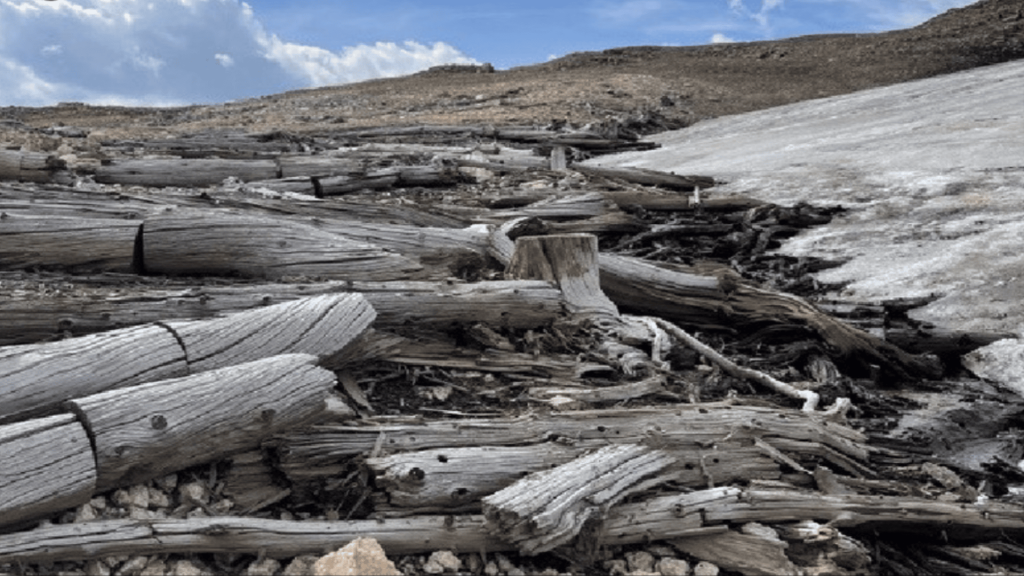Forest that froze 5,000 years ago uncovered due to climate change – Interesting Engineering

Thanks to climate change, researchers from Montana State University discovered a 10,000-year-old ancient forest that holds valuable information about climate change. a day ago2 days ago2 days ago2 days ago2 days ago2 days ago2 days ago3 days ago3 days ago3 days ago30 minutes ago2 hours ago4 hours ago5 hours ago8 hours ago8 hours ago8 hours ago10 hours ago11 hours ago11 hours agoMaria MocerinoThe sampled subfossil whitebark pine trees along the margin of the TOL ice patch. Photo by Daniel StahleThough climate change has caused ice to melt high in the Rocky Mountains, researchers discovered an ancient forest lingering in the frost with, interestingly enough, invaluable insights to share about past climate change.“Recent warming has substantially transformed mountain ecosystems through reductions in snow and ice,” the authors of a new study write. Though loss is imminent, a recent field survey gained valuable information about climate change in the past.Researchers from the Department of Earth Sciences at Montana State University discovered 30 well-preserved large trees due to the global melt on an ice patch on the Beartooth Plateau in the northeastern corner of the Greater Yellowstone Ecosystem.Identified as stunningly preserved whitebark pine (Pinus albicaulis) that died 5,000 years ago due to a significant climate shift, the ancient forest provides information pertaining to its “establishment, demise, and preservation” within the ice patch, study authors note in a new study published in PNAS.As climate change continues to impact ecosystems worldwide, at least science can learn a thing or two from a seriously pristine set of trees that once grew at surprisingly high elevations that might benefit us today.At an elevation of 10,000 feet, Beartooth Plateau, though an arid landscape today, evidently once produced trees. “The extraordinary quality of wood preservation” has effectively left researchers with a detailed climate snapshot.Today, whitebark pines grow at much lower elevations. But due to two series of climate warming periods 10,000 and 5,000 years ago, these trees grew higher into Rocky’s picturesque mountain ranges, Live Science reports. But they did not survive the subsequent cold spell. A once thriving ecosystem that sustained animals and humans alike, volcanic eruptions created a “summer cooling anomaly” that led to rapid ice growth that preserved the trees until, today, as the ice has begun to melt, revealing the past’s natural treasures.Recent global warming temperatures have matched the levels prevalent in the mid-Holocene period about 5,000 to 7,000 years ago. They will even exceed the heat that the world reached back then. The ice cover will disappear from the region, most likely, and “the treeline may expand upslope,” according to study authors.These ice patch archives hold climate records that are “rare and absent” from “interior continental proxies,” which refers to the physical characteristics in a specific region, including the Rocky Mountains, that can be used to study ancient climates. Researchers even uncovered a 10,000-year-old wooden shaft that they believe might have been part of a hunting spear, study authors told Live Science. No one even knew that these patches of ice had been around for thousands of years. As temperatures continue to rise worldwide, causing ice patches to melt, who knows what researchers will find lurking beneath the exceptionally preserved permafrost? Studying past climates provides crucial information about our weather patterns. Ancient forests can assist scientists in continuing to predict and understand how shifts and changes will impact us in the future.“Investigating long-term ecosystem responses to a range of high-elevation climate conditions over the Holocene facilitates our ability to assess current and future treeline dynamics, study authors conclude in the study in PNAS. Unfortunately, they conclude to Live Science that alpine forests are extremely susceptible to climate shifts. Stay up-to-date on engineering, tech, space, and science news with The Blueprint.By clicking sign up, you confirm that you accept this site’s Terms of Use and Privacy PolicyMaria Mocerino Originally from LA, Maria Mocerino has been published in Business Insider, The Irish Examiner, The Rogue Mag, Chacruna Institute for Psychedelic Plant Medicines, and now Interesting Engineering.a day agoa day agoa day agoa day agoPremiumIE PROFollow
Source: https://interestingengineering.com/science/10000-year-old-frozen-forest-found-in-the-rockies






